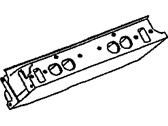
Why choose GMPartsGiant
- Large Inventory
The excellent site to buy genuine parts for years has been GMPartsGiant.com. We're the optimal online parts and accessory store for your Pontiac Phoenix. GMPartsGiant.com offers a large parts and accessory inventory to cover all your vehicle's repairs. Feel free to browse through our genuine Pontiac Phoenix parts and accessory catalog to find all your vehicle's needs.
- Fast Shipping Times
All of our Pontiac Phoenix parts and accessories are expedited directly from verified dealers and backed by the manufacturer's warranty. Our experienced team ensures the orders are packed to provide quick transit times. The majority of the orders are shipped out within a couple of business days to get the parts out to you as fast as possible.
- Low Prices
Our low prices say it all. You can rest assured that you will always receive unbeatable prices on OEM Pontiac Phoenix parts. Our giant inventory is beyond compare and has everything you need at an extraordinary value not found anywhere else. Whether you're restoring an old vehicle or upgrading the performance of your Pontiac Phoenix, you can count on the quality of our products without hurting your bank account.
Popular Genuine Pontiac Phoenix Parts
- Engine Parts View More >
- Front Suspension, Steering Parts View More >
- Fuel System, Exhaust, Emission System Parts View More >
- Brakes Parts View More >
- Transmission - Automatic Parts View More >
- Frames, Springs, Shocks, Bumpers Parts View More >
- Front End Sheet Metal, Heater Parts View More >
Shop Genuine Pontiac Phoenix Parts with GMPartsGiant.com
The Pontiac Phoenix, produced from 1977 to 1984, is a small, affordable car crafted with the commuter and small family in mind. Developed on the GM X chassis, this reliable model underwent two generations before being discontinued. The first generation offered a two-door coupe, a three-door hatchback, or a four-door sedan, manufactured in New York and Michigan. This generation saw engine options ranging from 2.5-liter to 5.7-liter, coupled with 3-speed manual, 4-speed manual, and THM350 3-speed automatic transmissions. The Phoenix was an upgrade to the Pontiac Ventura, with differences in minor details like diamond-shaped headlights and yellow taillights. The second generation (1980-1984) ushered in changes like front-wheel drive and was offered as a 5-door hatchback or 2-door coupe. This period introduced the SJ package in 1982, alongside engine parts from earlier models. The powerful 2.8L LH7 became standard on the SJ/SE model and was offered as an option on all other Phoenix models. Notably, the Pontiac Phoenix is celebrated for its fuel efficiency, achieving 30 miles to the gallon on standard gasoline. It offers ample interior space and comfort for a family of four, making it an excellent family car. Ease of handling, robust Pontiac Phoenix parts, and sufficient power add to the driving enjoyment, while generous trunk storage provides practicality. Overall, the Phoenix stood as a solid, consistent performer in the small car market.
For unrivaled quality, OEM parts are the ultimate choice. These parts are manufactured by Pontiac's official factory using top-quality materials and undergo strict testing procedures, ensuring outstanding dependability and long-lasting durability. If you're on the hunt for OEM Pontiac Phoenix parts, such as Transmission - Manual, we strongly encourage you to explore our wide selection of Pontiac Phoenix parts, all available at the most competitive prices. We guarantee that all our genuine Phoenix parts are accompanied by a manufacturer's warranty and an effortless return policy. We surpass numerous competitors when it comes to price, quality, and reliability.
Pontiac Phoenix Parts Questions & Answers
- Q: How should the gasket surfaces on both the cylinder heads and the engine block be cleaned and prepared for installation on Pontiac Phoenix?A: Thoroughly clean the gasket surfaces on both the cylinder heads and the engine block without scratching or damaging these sealing areas. Ensure the threads of the attaching bolts and the threaded holes in the engine block are free of dirt by running a tap through these holes. Place the gasket over the engine block dowel pins and carefully lower the cylinder head onto the engine, ensuring the gasket remains in place. Coat the threads of the cylinder head attaching bolts and the area where the head and stem meet with a sealing compound, installing each bolt finger-tight without tightening them at this stage. Tighten each bolt gradually in the specified sequence until the proper torque reading is achieved, then check to ensure none of the bolts were missed in the sequence. Install the exhaust manifold(s) and each valve lifter into its proper bore, using Molykote or an equivalent coating on each lifter. Apply a small amount of Molykote or its equivalent on each end of the pushrods before installing them in their original positions, ensuring they are seated properly in the lifter cavity. Place each rocker arm and corresponding rocker balls onto their original studs, applying a small amount of Molykote or its equivalent to the rocker balls and valve stem ends. For L4 engines, torque the rocker arm nuts/bolts to specifications. Install the rocker arm covers, applying a bead of RTV sealer around the entire sealing surface of the cylinder head, ensuring the bead is 1/18-in wide and going around the inboard side of the bolt holes. Install the cover while the sealer is still wet and torque the bolts to specifications. Install the intake manifold with new gaskets and the remaining engine components in the reverse order of removal. Finally, fill the radiator with coolant, start the engine to check for leaks, adjust the ignition timing as necessary, and recheck the coolant level once the engine has warmed up to operating temperature.













































